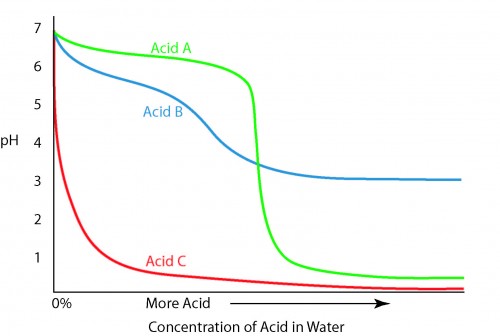Previous blogs have revealed a number of ways to measure chemical concentration in a cleaning bath. It is a logical extension that process engineers utilize these tools to automate maintaining the proper chemical concentration in their cleaning processes. Overall, this is a great idea. However, there are some pitfalls and things that should be taken into consideration along the way.
1) The first consideration should be the appropriateness of the system for automated chemical addition. Whatever measure is used to determine chemical concentration should be sensitive but not over-sensitive to changes in concentration. For example, highly caustic solutions such as those containing sodium hydroxide will not change much in pH over a wide range of concentration. They will pretty much read pH 13 no mater what the concentration is. In this case, specific gravity might be a better choice as the parameter to measure concentration.
Another example of a potential problem is an acidic chemistry which has a steep pH curve as shown in an earlier post.

In this example, acids “A” and “C” would not be good candidates for automatic chemical makeup due to the steepness of the pH curve. Acid “B” on the other hand would be a great candidate for control by measuring pH at least to the point where the pH curve reaches 3 and becomes flat.
Note – I have seen cases where the addition of as little as a few milliliters of and acidic chemistry to a 30 gallon tank would take a cleaning bath from below the target range to substantially above he target range. In that case, control using pH was not possible!
2) It is best if the concentrated chemistry to be added is a liquid. Metering pumps and other devices are available that can accurately measure the amount of liquid added. Although there are also devices that measure dry chemicals by weight or volume, they seem to be more prone to inaccuracy than the liquid feeders. If the chemistry is available as a dry powder or as a liquid, my choice would be the liquid version.
3) The sensor of the instrument measuring concentration should be positioned in the liquid volume so that it measures the average concentration in the bath. To accomplish this, it is best if there is some form of mixing present. This could be something that exists, like a pump and filter or an “add on” in the form of a properly sized propeller-type mixer. In any event, the sensor should not be located in a plumbing line where there is likely to be stagnation (such as in the plumbing of a pump and filter loop or spray riser which operates only intermittently).
4) Chemical addition should be made in measured doses and not as a continuous flow until the sensor is satisfied. Even in what would appear to be a well-mixed tank, there will be some lag between the time that the chemical is added and the time that the sensor sees the result of the addition. In some cases (as in the case of an automated titrator) the sensor itself is responsible for some delay. Once the sensor calls for a chemical addition, a shot of chemistry (less than would be required to make the entire correction) should be added. Further small additions should be made until the sensor is satisfied. Adding chemistry in one shot until the sensor is satified will inevitably lead to an over-correction.
5) Finally, whatever measure is used to determine concentration should tolerate a reasonably wide range rather than a single set point. If concentration is so critical that no deviation can be tolerated, manual control is probably the best bet.
The use of automated means to control chemical concentration is common and often a great tool to help control an overall process. It is not, however, applicable in every situation.
– FJF –



 English
English Spanish
Spanish Chinese
Chinese Canada
Canada Mexico
Mexico United Kingdom
United Kingdom



